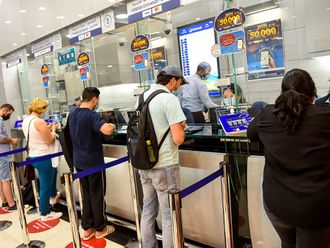
Dubai: A year after the UAE-India CEPA deal came into effect, the stage is set for the next big bang in trade and investment flows between the countries – a dirham-rupee payment mechanism.
When that happens, multiple categories - and businesses within them - would benefit from closing deals in the two currencies and not have to use US dollars to make it happen. What that does is cushion trade between the countries from foreign exchange volatility brought on by the dollar’s movements.
“India is looking to ways that can speed up and smoothen out trade with its biggest economic partners,” said a senior Indian government source. “We have learnt the processes well in using the rupee in financing imports from Russia, and it’s been a major factor in limiting inflationary pressures in the economy.
“If India and UAE sign a deal confirming rupee-dirham, it will further expand the scope of CEPA.”
Read More
- Under CEPA, India opens up gold imports from UAE to bullion traders too in a win for all
- CEPA deal sets UAE-India for greater global cooperation, says Dr. Thani
- With CEPA, India-UAE trade can easily ‘surpass’ $100b, says Piyush Goyal
- After CEPA, UAE funds busy chasing India’s next Unicorns: Neelesh Bhatnagar of NB Ventures
Meeting CEPA targets - and then some
It was with India that the UAE entered into its first CEPA – or the Comprehensive Economic Partnership Agreement - that immediately brought down import duty across categories and opened up new investment possibilities for entities in these countries.
What UAE and India are looking for are to go in for immediate benefits from CEPA where possible and then work on those areas where they can make steady progress.
“I'm not aware of any UAE imports that are subject to 0 per cent import duty in India,” said Raju Menon, Chairman and Managing Partner at Kreston Menon, the audit consultancy. “However, under CEPA, India has agreed to reduce or eliminate tariffs on a range of products imported from the UAE.

“The UAE has agreed to provide tariff concessions to India on 60 per cent of items traded between the two, including on basmati rice, textiles, and pharmaceuticals.” (India last week reworked the processes involved for the country’s gold trade to source bullion from the UAE under CEPA. This could in the coming months see UAE provide up to 140 tonnes of bullion to India, and which will consolidate its status as the second biggest supplier of gold to that market after Switzerland.)
Trade is on the up
Trade gains have been there from the start of the CEPA becoming effective from May 1. Between April to November 2022, two-way movements totalled $57.8 billion from $45.3 billion a year prior to that. That’s a rise of $12.5 billion in value terms and 27.5 per cent in percentage terms.
India's exports to the UAE went past $20 billion during this period, leveraging a 19.32 per cent increase.
“As per the CEPA agreement, there would be periodic reviews to assess progress and identify areas for further cooperation,” said Menon. “The UAE has set up a dedicated task force to ensure the smooth implementation of the agreement, while India has created a website to provide information about the CEPA and facilitate trade between the countries.”
Beyond $100b in trade
Boosting two-way trade to $100 billion is the stated aim before the end of this decade, but there is also the greater emphasis on generating more from trade in services, with a target of $15 billion.
The cable-maker Ducab Group recently opened an office in the south Indian metropolis of Bengaluru, and its CEO Mohammed Abdul Rahman Al Mutawa was there on the ground. And he’s liking what’s showing up as possibilities post-CEPA.
“India is our new home market,” said Al Mutawa. “India has always been of interest to us and CEPA made the decision of opening an office in Bengaluru easier.
“Ducab has been supplying to the Indian market since 1988, with its first project being the Nhava Sheva Port in Mumbai. Ducab has supplied 263,000 MT of of CuEq (copper equivalent) of metals to the market through the years. This is equal to powering approximately 3 million houses.

The other big investments or commitments made by UAE businesses are by the likes of Emaar, LuLu and the Sharaf Group, while DP World is expanding the scope of its already substantial interests in that market.
What India offers UAE business under CEPA
- Enhanced access to the Indian market in sectors such as healthcare, education, and renewable energy.
- Investment protection.
- India has taken several measures to streamline procedures for setting up businesses, including online registration and simplified paperwork requirements.
- The CEPA includes provisions for the protection of intellectual property rights, which can be particularly important for businesses operating in sectors such as tech and pharmaceuticals.
- The deal includes provisions for the mutual recognition of professional qualifications, which can make it easier for businesses to access this talent pool.
But business chiefs say it is still too early to fully realise the full possibilities that come with CEPA. "The impact of such agreements can take time to be felt, as businesses need to navigate through the legal and regulatory requirements of investing in a foreign country," said Abdul Jebbar P. B., Group Managing Director at Dubai-based Hotpack Global, currently on a major expansion in the UAE and Saudi Arabia.

India is becoming one of the most desirable markets for businesses from all over the world due to its sheer size. And the government has been prudent in encouraging investment."
With CEPA, UAE businesses with an India focus might have that extra edge.












